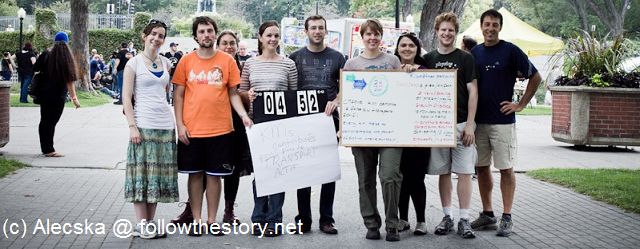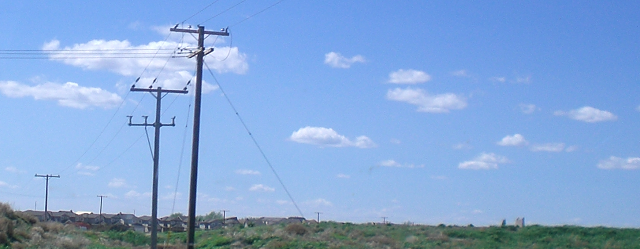Preface This document is a response to the draft documents posted as part of the Design Regina process. The authors of this response are also the primary authors of Transforming Regina: Planning for 2040 and beyond, which achieved a place in the finals of the Regina Morph My City competition. Readers interested in a detailed […]
Tag: Energy
Harvest and Hunger: Brainstorming the future of the world food system
Harvest and Hunger The Saskatchewan Council for International Cooperation is hosting an event in Saskatoon on November 10th called Harvest and Hunger. The event sets out to answer three questions: Who controls the world’s food? Who has power in the global food system? Who doesn’t? What are people doing – both in Saskatchewan and around […]

Moving Planet Montreal
Moving Planet Montreal was a celebration of the transition away from fossil fuels in our society. The event was a green kilometer drive and a grand picnic, symbolizing the central role of transportation and food in sustainability.
Envisioning a Green Life: 10 ways you can make a difference
Simple, practical advice on how to live a green life. Based on years of research and thought on the matter by the Vision of Earth team.
Ben’s Interview on Radio CKUT 90.3 FM
Ben Harack was interviewed on the Ecolibrium radio show on CKUT in Montreal. Topics were Moving Planet, Saskatchewan’s sustainability, and peer-based cross-disciplinary efforts towards sustainability.

Opportunities and perils of natural gas usage on the road to renewables
Our increasing reliance on natural gas brings with it both opportunities and dangers during the shift towards renewable energy. This issue deals with some major issues regarding natural gas deployment in industry, power generation, food production, and heating.

Capitalism’s Labour Transitions – An Argument for Social Welfare
Capitalist labour transitions are a heavy burden on the working class and society in general, but they are also one of the cornerstones of progress. We can solve this problem in an economically practical as well as morally and socially desirable through the creation of a strong social welfare system.

A renewed look at 2010, a sustainable vision for 2011
Here we review major renewable energy topics from 2010 and then turn towards analyzing energy issues for 2011 and beyond.

Curtis Dorosh: Green living, building, and volunteering
How to live green? Build green buildings? Put our efforts towards a better future? Curtis Dorosh has spent much of his life trying to answer these questions. Collected here are some of his answers.
Demand side management to help build a renewable power grid
Demand side management helps make our power grid more cost-effective and aids in the transition towards renewable energy. It can also be considered as a very green policy on its own, as it reduces the amount of power we need to produce, and thus our impact on the environment.
31 Ways to Reduce Paper Usage
Why should we care about our paper usage? For me the key points are that it is an expensive, impermanent storage medium that is made primarily out of those wondrous things we call trees.
Power system performance metrics
Everything has its price. Every form of power production has costs in dollars, time, land, materials, pollutants, greenhouse gas emissions, and human deaths. We look at the most important factors for analyzing the feasibility of a proposed power project. Considering only some of these factors will lead to an incomplete picture of power system costs.
Fusion fast ignition systems
Fusion ‘fast ignition’ systems are some intriguing new possibilities for fusion development. They may make it possible for humanity to achieve functional fusion reactors in a few decades.
Laser implosion fusion reactors
Laser implosion fusion is a proposed method for creating nuclear fusion power plants. It is showing some great promise, being the most likely candidate for the first fusion method to reach net energy gain. Exciting new developments may make fusion power a reality in the coming decades.
Interview with wind power guru Paul Gipe
Wind power expert Paul Gipe advocates that we deliberately create our green energy future rather than wait around for it to happen. He says that we should aim to democratize our energy production for a more prosperous future.
How do we turn nuclear fusion energy into electricity?
How do we turn fusion power into electricity? There are two main methods. We can use heat engines like steam turbines or we can use a very new system called ‘direct conversion’ which has some interesting properties.
The basic realities of fusion reactor design
Issues and difficulties with creating a physical system for nuclear fusion. To succeed, we must face temperatures that vaporize all known materials and other requirements that make this the most difficult technological endeavor of our age.
Fusion fuel cycles: What they are and how they work
There are a number of different fuels that can be used for creating fusion power. Here we look at the useful ones and look at their advantages and disadvantages. Different fuel cycles require very different implementations.
How can renewables deliver dispatchable power on demand?
What does dispatchable mean? Why is it important? How do we currently do this? Can renewable energy fulfill this role? What other tricks can we use?
Helpful tools for understanding nuclear fusion
These are the concepts I found to be very useful during my fusion research. Here we define ignition state, Lawson criterion, fusion performance parameter, and energy gain factor Q.